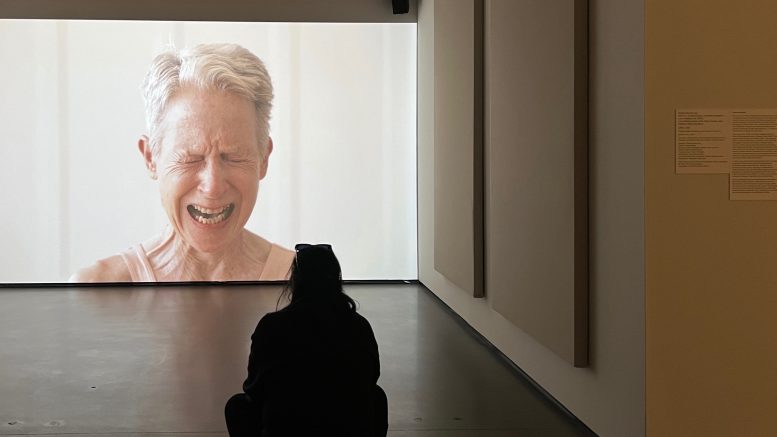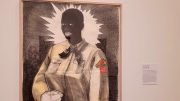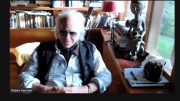By Casey Rafter
Decades of experience guided the dancer’s movements as she silently shifted her arms, her hips and back, her legs — all in a fluid, slow dance, showing the ease with which she accomplished her stretches and the shifts in her body, even in her advanced age. Her eyes closed, the next scene revealed every sign of Meg Harper’s 80 years on the surface of her skin, magnified in even finer detail in the close up shot.
Harper is the center focus of South Korean/LA artist Kang Seung Lee’s film “Skin,” part of “Entangled Writing,” one of three temporary exhibits open at the UC Davis Manetti Shrem Museum of Art.
The death of Jan Shrem, a founding donor to the museum, in September at 94, aligns with another exhibition at Manetti Shrem: “Light into Density: Abstract Encounters 1920s–1960s.” In the wake of Shrem’s death, visitors to the free museum have an opportunity to reflect on pieces taken directly from Shrem’s private collection.
Shrem, a philanthropist and visionary alongside his wife, Maria Manetti Shrem, was instrumental in creating a museum at UC Davis that not only celebrates art, but fosters community, education and cultural exchange. Since its opening in 2016, the museum has become a center for artistic exploration, reflecting Shrem’s mission to empower artists to connect and transform.
“Both [Jan] and Maria have been very involved; from gifts to campus, supporting the galas and supporting internships,” said Laura Compton, Manetti Shrem’s communication director. “He came to every gala — every special event we would do here.”
This fall, the Manetti Shrem Museum celebrates Shrem’s lasting influence through three distinctive exhibitions that embody his ethos. The three exhibits — “Entangled Writing,” “Light into Density” and “Ritual Clay” — offer innovative explorations of language, transcendence and ceramics, inviting visitors to engage with art on sensory, intellectual and spiritual levels.
Entangled Writing: language as art

As a comment on the intersection of language and visual art, “Entangled Writing” reimagines writing as an expressive medium that interacts with space, emotion and identity. Compton said the exhibition is Manetti Shrem’s largest group of works the museum has commissioned to date, including works from four California artists: Phillip Byrne, UC Davis Associate professor of Art Beatriz Cortez, Kang Seung Lee and Candice Lin.
“It actually came out of Beatriz Cortez, who was doing the California studio residency,” said Susie Kantor, associate curator and exhibition department head at the museum. “I think materiality is a sub theme of the exhibition. They’re all intentional in their materials and thinking about what the materials mean, where they come from and how they use them.”
The works in “Entangled Writing” invite visitors to reconsider the power of words, transforming them from simple text into tangible, multidimensional art. Byrne, who holds an MFA in studio art from UC Davis, created installations that feature discarded materials the artist repurposed, using staples and zip ties to bring together lengths of dissected cable casings, stones and flattened air ducts to resemble cocoons or internal organs. Cortez’s work highlights the language of migration, blending words with imagery to evoke movement and displacement.
Observing her work, it’s immediately evident that strenuous effort and tedious time were invested to create large steel structures covered in smoothed out dents and welds in cellular fashion. Lee’s film “Skin” and its stationary counterparts at the museum offer meditative glances at the human form, questioning the limitations and potential of language as a tool for expression. Lin’s work, in contrast, combines text with symbolic materials, examining the role of language in personal and collective histories.
“I’ve been living with these works or these artists in my head for two years and I’m still making discoveries and connections,” Kantor said. “How do you preserve memory, both in the body, physically and emotionally across time? They were not talking to each other in the making of the work, but those beautiful kinds of connections are what I keep coming back to, more than the individual works themselves.”
The exhibit runs until December 29.
Light into Density: the art of perception
For the first time, the Manetti Shrem Museum has mounted an exhibit fully curated and designed by students. Fifteen pieces of abstract art collected by Jan and Maria Manetti Shrem are featured in this groundbreaking exhibition with a presentation organized by 32 students from art history, museum studies and design programs.
“I am so delighted this exhibition is happening after 30 years,” Maria Manetti Shrem said. “It’s the first time these unparalleled works of 20th-century art will be shown together. It’s also very special that UC Davis students worked to curate such a unique exhibition.”
The show includes pieces from iconic 20th-century artists such as Francis Bacon’s “Skull of a Gorilla,” Salvador Dalí’s “Unsatisfied Desires,” which shows the artist’s use of textural items like sand and ground shells to compliment the oil painting on the canvas. This marks the first public presentation in decades for some of the works, according to Compton, offering a rare opportunity to experience them together in a new and dynamic context.
“These are all paintings that Jan collected when he lived in Paris in the ’60s and ’70s and got to know the artists,” Compton said. “A lot of cases, they’re very personal. [Some] actually came directly from their apartment.”
The students who curated the exhibit worked throughout the academic year to research, design, and interpret the display. Their aim was to demystify abstract art and foster a space where visitors could engage with the works on a personal level, Compton said.
The exhibition runs until May 5, 2025.
Ritual Clay: the sacred and the craft

The third exhibition active at the Manetti Shrem Museum, “Ritual Clay,” explores the historical and spiritual significance of ceramics. Drawing on ancient traditions, the clay vessels and installations demonstrate the intersection of art, ritual and spirituality. Each piece invites viewers to contemplate the connection between the physical and metaphysical.
Ginny Duncan, curator of “Ritual Clay,” explains that the exhibition focuses on the ancient roots of pottery as both a practical and spiritual practice. One of the vessels on display, created by artist Paz G, is decorated with angelic figures, covered in holes that resemble exit wounds. Duncan spectated that the holes represent entry points for the angels and spirits depicted on the container.
Paz G also created what Duncan called “portals” around some of their pieces in the exhibit. These are brightly colored circles painted directly onto the walls behind the vessels on display, adding a vibrancy that pulls the viewer into each piece. Duncan notes that the artist intended for the pieces to evoke a sense of out-of-the-ordinary communication with the natural world.
“The way they described how they make these vessels, they can also function as musical instruments if wind comes through the holes a certain way,” Duncan said. “It’s the idea of wind, air or the spirit coming through the vessel.”
Duncan said the centerpiece of the exhibit, Cathy Lu’s “Nuwa With Drain,” arrived at the museum in several pieces but no exact model to guide placement of the ceramic pieces, giving her the freedom to plan the piece’s shape and placement uniquely. The resulting configuration is about seven feet long, resembling a glossy snake-like object with thin-fingered hands on either end reaching upwards.
As with “Entangled Writing” and “Light into Density,” “Ritual Clay” celebrates not only the tactile beauty of the objects but also their cultural and spiritual significance, inviting visitors to reflect on the continuity of human creativity and ritual.
The exhibit runs through December 29.
These exhibitions embody the spirit of Jans legacy, honoring his commitment to creating a space where art is not just observed, but experienced — where it sparks dialogue and encourages personal reflection.
“We want people to feel something when they walk into the museum,” Compton said. “Art isn’t just something you look at — it’s something you engage with, something that stays with you.”
This story was funded by the City of Sacramento’s Arts and Creative Economy Journalism Grant to Solving Sacramento. Following our journalism code of ethics and protocols, the city had no editorial influence over this story and no city official reviewed this story before it was published. Our partners include California Groundbreakers, Capital Public Radio, Outword, Russian America Media, Sacramento Business Journal, Sacramento News & Review, Sacramento Observer and Univision 19. Sign up for our “Sac Art Pulse” newsletter here.





Be the first to comment on "Art meets legacy: Exploring Manetti Shrem’s latest exhibitions in Davis"